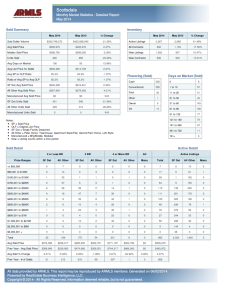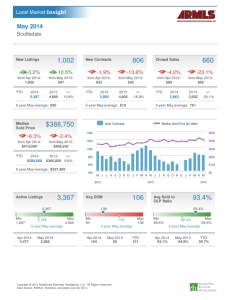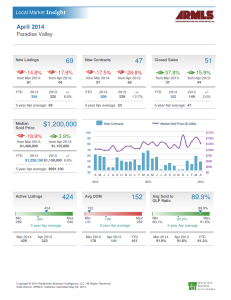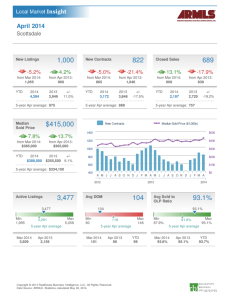Millennials vs. Baby Boomers: What Do They Want? By Joe Szabo, Scottsdale Real Estate Team
Location
 Millennials aren’t the only ones flocking to popular cities such as New York, Boston, Miami and San Francisco. Some boomers are, too. After all, they want the theater, arts, culture and fine dining! The difference is that millennials, if they’re not still living with mom and dad, are moving into expensive rental units. An analysis that Zillow recently conducted for The New York Times showed that in 90 cities, the median rent is more than 30 percent of the median gross income. Meanwhile, some well-heeled boomers — eager for a lifestyle change — are buying smaller, yet more expensive homes than the ones where they raised their families in the suburbs. How’s that for downsizing?
Millennials aren’t the only ones flocking to popular cities such as New York, Boston, Miami and San Francisco. Some boomers are, too. After all, they want the theater, arts, culture and fine dining! The difference is that millennials, if they’re not still living with mom and dad, are moving into expensive rental units. An analysis that Zillow recently conducted for The New York Times showed that in 90 cities, the median rent is more than 30 percent of the median gross income. Meanwhile, some well-heeled boomers — eager for a lifestyle change — are buying smaller, yet more expensive homes than the ones where they raised their families in the suburbs. How’s that for downsizing?
Style
 A nice, yet casual-looking social hub is what millennials look for. Practicality is what it’s all about. Boomers, on the other hand, really want more of a private retreat — think vacation-like. After all, they’ve worked hard for it so why not enjoy the fruits of their labor? Boomers want their next, and final, home to be the best ever — the picture of success.
A nice, yet casual-looking social hub is what millennials look for. Practicality is what it’s all about. Boomers, on the other hand, really want more of a private retreat — think vacation-like. After all, they’ve worked hard for it so why not enjoy the fruits of their labor? Boomers want their next, and final, home to be the best ever — the picture of success.
Amenities
 Millennials and boomers alike both want clean, shiny and new move-in ready homes. And they both seem to value amenities over square footage. Accessibility and walkability are also important. But while millennials put speedy, reliable Internet performance (built-in docking stations and charging panels are a given) at the top of their must-have lists, boomers are more keen on luxury and flaunting niceties — from state-of-the-art kitchens to fancy bathrooms, large walk-in closets and more.
Please note that this Scottsdale Real Estate Blog is for informational purposes and not intended to take the place of a licensed Scottsdale Real Estate Agent. The Szabo Group offers first class real estate services to clients in the Scottsdale Greater Phoenix Metropolitan Area in the buying and selling of Luxury homes in Arizona. Award winning Realtors and Re/MAX top producers and best real estate agent for Luxury Homes in Scottsdale, The Szabo group delivers experience, knowledge, dedication and proven results. Contact Joe Szabo at 480.688.2020, [email protected] or visit www.scottsdalerealestateteam.com to find out more about Scottsdale Homes for Sale and Estates for Sale in Scottsdale and to search the Scottsdale MLS for Scottsdale Home Listings.
Millennials and boomers alike both want clean, shiny and new move-in ready homes. And they both seem to value amenities over square footage. Accessibility and walkability are also important. But while millennials put speedy, reliable Internet performance (built-in docking stations and charging panels are a given) at the top of their must-have lists, boomers are more keen on luxury and flaunting niceties — from state-of-the-art kitchens to fancy bathrooms, large walk-in closets and more.
Please note that this Scottsdale Real Estate Blog is for informational purposes and not intended to take the place of a licensed Scottsdale Real Estate Agent. The Szabo Group offers first class real estate services to clients in the Scottsdale Greater Phoenix Metropolitan Area in the buying and selling of Luxury homes in Arizona. Award winning Realtors and Re/MAX top producers and best real estate agent for Luxury Homes in Scottsdale, The Szabo group delivers experience, knowledge, dedication and proven results. Contact Joe Szabo at 480.688.2020, [email protected] or visit www.scottsdalerealestateteam.com to find out more about Scottsdale Homes for Sale and Estates for Sale in Scottsdale and to search the Scottsdale MLS for Scottsdale Home Listings.Infographic: Why Is 20% Ideal for a Down Payment? By Joe Szabo, Scottsdale Real Estate Team
 Please note that this Scottsdale Real Estate Blog is for informational purposes and not intended to take the place of a licensed Scottsdale Real Estate Agent. The Szabo Group offers first class real estate services to clients in the Scottsdale Greater Phoenix Metropolitan Area in the buying and selling of Luxury homes in Arizona. Award winning Realtors and Re/MAX top producers and best real estate agent for Luxury Homes in Scottsdale, The Szabo group delivers experience, knowledge, dedication and proven results. Contact Joe Szabo at 480.688.2020, [email protected] or visit www.scottsdalerealestateteam.com to find out more about Scottsdale Homes for Sale and Estates for Sale in Scottsdale and to search the Scottsdale MLS for Scottsdale Home Listings.
Please note that this Scottsdale Real Estate Blog is for informational purposes and not intended to take the place of a licensed Scottsdale Real Estate Agent. The Szabo Group offers first class real estate services to clients in the Scottsdale Greater Phoenix Metropolitan Area in the buying and selling of Luxury homes in Arizona. Award winning Realtors and Re/MAX top producers and best real estate agent for Luxury Homes in Scottsdale, The Szabo group delivers experience, knowledge, dedication and proven results. Contact Joe Szabo at 480.688.2020, [email protected] or visit www.scottsdalerealestateteam.com to find out more about Scottsdale Homes for Sale and Estates for Sale in Scottsdale and to search the Scottsdale MLS for Scottsdale Home Listings.Protecting Your Home Away From Home By Joe Szabo, Scottsdale Real Estate Team
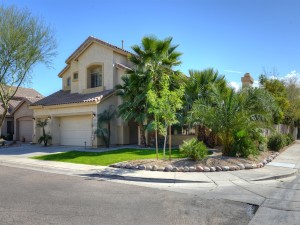 By Joe Szabo, Scottsdale Real Estate Team
A vacation home should be a paradise — a safe haven from the bustle and stress of everyday life. For those who rent out their properties for parts of the year, vacation homes also can be an additional source of income. But protecting those assets from natural and manmade disasters takes work and money.
The smart vacation homeowner makes sure the second home doesn’t generate more stress than it relieves. The right insurance coverage can go a long way toward putting an owner’s mind at ease.
By Joe Szabo, Scottsdale Real Estate Team
A vacation home should be a paradise — a safe haven from the bustle and stress of everyday life. For those who rent out their properties for parts of the year, vacation homes also can be an additional source of income. But protecting those assets from natural and manmade disasters takes work and money.
The smart vacation homeowner makes sure the second home doesn’t generate more stress than it relieves. The right insurance coverage can go a long way toward putting an owner’s mind at ease.
Standard homeowners policies won’t do it all
You may think the homeowners insurance policy on your primary residence fully protects you and your possessions. Many standard policies do include some coverage for personal property at an additional residence, but protection for a second home typically doesn’t go any further than that unless you’ve purchased a second policy. If you took out a mortgage on your vacation home, your lender likely required you to buy a separate home insurance policy. However, vacation homes come with unique risks, so standard coverage may not include all the protection you really need. Some insurance carriers offer coverage options specifically designed for vacation homes. For others, you’ll have to navigate the fine print yourself. Here are a few of the biggest risks and potential coverage gaps for vacation home owners, as well as suggestions on how to overcome them.Location, location location
Unfortunately, the qualities that make a location perfect for your dream home are often the same qualities that make it an insurance nightmare. Consider an oceanfront property, for example. In addition to being susceptible to hurricanes — wind and hail damage account for nearly half of all homeowners insurance claims per year, according to the Insurance Information Institute (III) — they also frequently experience flooding, which is not covered under most standard policies. Mountain homes have a problem, too; standard policies typically exclude all forms of earth movement, including landslides.Vacancies leave you vulnerable
If your vacation home is not your primary residence, it’s probably safe to assume it will sit unoccupied for several weeks or months every year. In terms of risk, consider the possibility of a small electrical fire or a leaky pipe in an empty house. Both could escape notice until they become serious threats. Additionally, burglars and trespassers are more likely to target homes that appear unoccupied. Considering the average costs per claim for these three hazards combined (fire, water damage and theft) totaled more than $44,929 in 2013 (according to the III), it’s certainly worth it to take a few easy precautions to ensure you won’t face these costs on your own. First, make sure your policy’s coverage limits line up with your home’s current replacement cost. Then see that your electrical and plumbing systems are up to date and in good shape. It’s not a bad idea to hire a professional for a thorough inspection.Leasing liabilities
One way to circumvent the risks of leaving your vacation home vacant is to rent it to tenants while you’re away. But don’t assume you’ll just pocket easy money when you do. Neglecting to take proper precautions as a landlord also could end up costing you in the long run. Consider this: If one careless tenant leaves the stove on, damages your belongings or is injured while on your property, you could face the entire cost of cleanup, hospital bills and even lawsuit expenses — a tab that could easily top $30,000[1] — on your own. Homeowners insurance might cover you if you only occasionally rent out your home for short periods of time. However, it’s still a good idea to cover all your bases with background checks and lease agreements. You also should consider investing in an umbrella policy to help protect yourself against the extra liabilities of having tenants. If your vacation property is occupied by tenants for more than 4 weeks out of the year, it’s safe to assume standard coverage isn’t going to cut it. In order to protect yourself, you’ll need landlord’s insurance. Policies range from simple coverage for things such as fire and vandalism to open peril policies, which cover all circumstances except those specifically excluded in your policy.It’s not all bad news
If your dreams of enjoying a vacation home haven’t been crushed yet, there is some good news. Vacation homes typically qualify for the same safety discounts as your primary home, so responsible investments such as deadbolt locks, home security systems and other upgrades are typically met with relatively lower premiums. And don’t worry. Once you’ve taken care of all the paperwork, the hardest part of owning a vacation home is having to leave at the end of the season. Please note that this Scottsdale Real Estate Blog is for informational purposes and not intended to take the place of a licensed Scottsdale Real Estate Agent. The Szabo Group offers first class real estate services to clients in the Scottsdale Greater Phoenix Metropolitan Area in the buying and selling of Luxury homes in Arizona. Award winning Realtors and Re/MAX top producers and best real estate agent for Luxury Homes in Scottsdale, The Szabo group delivers experience, knowledge, dedication and proven results. Contact Joe Szabo at 480.688.2020, [email protected] or visit www.scottsdalerealestateteam.com to find out more about Scottsdale Homes for Sale and Estates for Sale in Scottsdale and to search the Scottsdale MLS for Scottsdale Home Listings.30-Year Fixed Mortgage Rates Fall Below 4 Percent for First Time Since October By Joe Szabo, Scottsdale Real Estate Team
 *The weekly mortgage rate chart illustrates the average 30-year fixed interest rate in six-hour intervals.
*The weekly mortgage rate chart illustrates the average 30-year fixed interest rate in six-hour intervals.
Lack of Inventory Squeezing First-Time Home Buyers Out of the Market By Joe Szabo, Scottsdale Real Estate Team
The Nation’s Most Affordable Homes Also the Most Likely to Be Underwater By Joe Szabo, Scottsdale Real Estate Team
“The unfortunate reality is that housing markets look to be swimming with underwater borrowers for years to come,” said Zillow Chief Economist Dr. Stan Humphries. “It’s hard to overstate just how much of a drag on the housing market negative equity really is, especially at the lower end of the market, which represents those homes typically most affordable for first-time buyers. Negative equity constrains inventory, which helps drive home values higher, which in turn makes those homes that are available that much less affordable.”
Negative equity has fallen for eight consecutive quarters, but fell at its lowest pace in almost two years in the first quarter as home value growth slowed. Negative equity fell from 25.4 percent in the first quarter of 2013 and 19.4 percent in the fourth quarter, while the pace of annual home value growth slowed to 5.7 percent in the first quarter, from 6.6 percent at the end of the fourth quarter. Looking ahead, the national negative equity rate is expected to fall to 17 percent of all homeowners with a mortgage by the first quarter of 2015, according to the Zillow Negative Equity Forecast. More underwater homeowners are freed from negative equity as home values rise, eventually surpassing the amount still owed on a mortgage. If home values rise more slowly, negative equity will recede more slowly. Homeowners are also freed from negative equity if their homes are foreclosed on, as homeowners’ debt is wiped from lenders’ books following foreclosure.
5 Ways to Dress Up Your Front Door By Joe Szabo, Scottsdale Real Estate Team
1. Decorate it
 There are nearly limitless possibilities for decorating your front door. You could simply paint it a different color (or colors), hang a wreath in the center or add a dramatic house number above or to the side. Other options include installing long shutters on either side or adding a playful, historic or decorative specialty door knocker. Online retailer Architectural Depot sells a wide range of knockers, from chili peppers to poodles, that are sure to make you smile when you come home at the end of a long day.
There are nearly limitless possibilities for decorating your front door. You could simply paint it a different color (or colors), hang a wreath in the center or add a dramatic house number above or to the side. Other options include installing long shutters on either side or adding a playful, historic or decorative specialty door knocker. Online retailer Architectural Depot sells a wide range of knockers, from chili peppers to poodles, that are sure to make you smile when you come home at the end of a long day.

